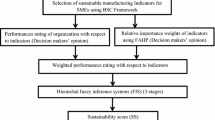Abstract
The purpose of this article is to report a research that has been carried out for assessing the sustainability of an organization using multi-grade fuzzy approach. Sustainability refers to the capability of an organization to maintain environmental safety and minimise resource utilisation. A sustainability model incorporated with multi-grade fuzzy approach has been designed. Subsequently, data gathered from a manufacturing organization has been substituted in the model and the improvement areas for enhancing the sustainability of the organization have been derived. The implementation study revealed that the organization is sustainable. But still, scope exists for improving sustainability of the organization. The usage of the model contributed in this project indicates the sustainability of the organization as well as the actions required to enhance its sustainability level. This process will accelerate the absorption of the sustainability characteristics of the modern organizations.

Similar content being viewed by others
References
Afgan NH, Darwish M, Carvalho MG (1999) Sustainability assessment of desalination plants for water production. Desalination 124:19–31
Amekudzi AA, Khisty CJ, Khayesi M (2009) Using the sustainability footprint model to assess development impacts of transportation systems. Transp Res 43:339–348
Benedetto LD, Klemes J (2009) The Environmental Performance Strategy Map: an integrated LCA approach to support the strategic decision-making process. J Clean Prod 17:900–906
Brunner N, Starkl M (2004) Decision aid systems for evaluating sustainability: a critical survey. Environ Impact Assess Rev 24:441–469
Calderon EJ (2000) An applied method for the assessment of sustainability of urban pilot projects. Environ Impact Assess Rev 20:289–298
Chen B, Chen ZM, Zhou Y, Zhou JB, Chen GQ (2009) Emergy as embodied energy based assessment for local sustainability of a constructed wetland in Beijing. Commun Nonlinear Sci Numer Simulat 14:622–635
Choi ACK, Kaebernick K, Lai WH (1997) Manufacturing processes modelling for environmental impact assessment. J Mater Process Technol 70:231–238
Kaebernic H, Kara S, Sun M (2003) Sustainable product development and manufacturing by considering environmental requirements. Robot Comput Integr Manuf 19:461–468
Lee YJ, Huang CM (2007) Sustainability index for Taipei. Environ Impact Assess Rev 27:505–521
Ljungberg LY (2007) Materials selection and design for development of sustainable products. Mater Design 28:466–479
Lozano R (2008) Envisioning sustainability three-dimensionally. J Clean Product 16(17):1838–1846
Munda G (2005) Measuring sustainability: a multi-criterion framework. Environ Dev Sustain 7:117–134
Noble BF (2002) The Canadian experience with SEA and sustainability. Environ Impact Assess Rev 22:3–16
Pope J, Annandale D, Saundersb AM (2004) Conceptualising sustainability assessment. Environ Impact Assess Rev 24:595–616
Pulselli RM, Simoncini E, Pulselli FM, Bastianoni S (2007) Emergy analysis of building manufacturing, maintenance and use: Em-building indices to evaluate housing sustainability. Energy Build 39:620–628
Ravetz J (2000) Integrated assessment for sustainability appraisal in cities and regions. Environ Impact Assess Rev 20:31–64
Robert K-H (2000) Tools and concepts for sustainable development, how do they relate to a general framework for sustainable development, and to each other? J Clean Prod 8:243–254
Ticehurst JL, Newham LTH, Rissik D, Letcher RA, Jakeman AJ (2007) A Bayesian network approach for assessing the sustainability of coastal lakes in New South Wales, Australia. Environ Model Softw 22:1129–1139
Tseng ML, Divinagracia L, Divinagracia R (2009) Evaluating firm’s sustainable production indicators in uncertainty. Comput Ind Eng 57:1393–1403
Ugwua OO, Haupt TC (2007) Key performance indicators and assessment methods for infrastructure sustainability—a South African construction industry perspective. Build Environ 42:665–680
Wiek A, Binder CS (2005) Solution spaces for decision-making—a sustainability assessment tool for city-regions. Environ Impact Assess Rev 25:589–608
Yagi K, Halada K (2001) Materials development for a sustainable society. Mater Design 22:143–146
Author information
Authors and Affiliations
Corresponding author
Rights and permissions
About this article
Cite this article
Vinodh, S. Assessment of sustainability using multi-grade fuzzy approach. Clean Techn Environ Policy 13, 509–515 (2011). https://doi.org/10.1007/s10098-010-0333-1
Received:
Accepted:
Published:
Issue Date:
DOI: https://doi.org/10.1007/s10098-010-0333-1




